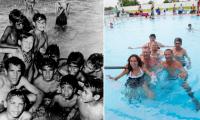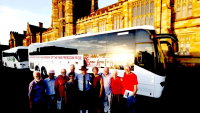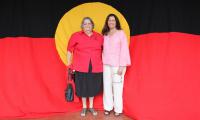More than a hundred Sydney of University students and staff have been taking part in the 50th anniversary re-enactment of The Freedom Ride, a major milestone in the civil rights struggle of Aboriginal people, led by the late Charles Perkins, the first Aborigine to graduate from an Australian university and the first first Aborigine to become a permanent head of a federal government department. Hear him explain the original Freedom Ride here. The four-day anniversary bus run took the demonstrators to the New South Wales western outback towns of Dubbo, Walgett and Moree, the Mid North Coast hinterland town Bowraville and the coastal town of Kempsey. There was shocking racism in all of them in 1965 . The two-week bus ride put Indigenous rights into the national spotlight.
"I think it was a rude awakening for some of the students," said the NSW Aboriginal Land Council's Roy Ah-see. "Today's re-enactment would...bring back a lot of memories for them."
On 20 February 1965, Perkins and his party tried to enter the swimming pool at Moree, where the local council had barred Aboriginal people from swimming for 40 years since it had been opened. In response to this action the riders faced physical opposition from several hundred local white Australians, including community leaders, and were pelted with eggs and tomatoes.
These events were broadcast across Australia, and under pressure from public opinion, the council eventually reversed the ban on Aboriginal swimmers. The Freedom Ride then moved on, but on the way out they were followed by a line of cars, one of which collided with the rear of their bus forcing them to return to Moree where they found that the council had reneged on their previous decision. At one stage during the Rides, the protesters' bus was run off the road.
The Freedom Riders protested again, forcing the council to again remove the ban.
Filmmaker Rachel Perkins, daughter of Charlie Perkins, said this year’s journey was a personal one. "I think the freedom ride for me personally reminds me about what you can do and what these people did," she said. "You don't think you have the power to change it but you do."
She was asked what her father would have wanted the second ride to stand for. She said a renewed focus on the situation of Indigenous Australia and that "we don’t let go of the thing that the Freedom Ride embodied, which is not accepting the status quo".
National Indigenous Television (NITV) reported that the 1965 Freedom Ride awoke Australians to racial segregation of Aboriginal people. Its reporters looked back at that and noted that “the civil rights protesters have received a very different welcome”.
In 1965 the Moree council would not allow Aboriginal people into the local swimming pool and the local club of the Returned and Services League (RSL), a support organisation for men and women who have served or are serving in the military, barred Aboriginal veterans from entering. Cinema seating was segregated.
NITV reporters listened to Moree Elders, who were only young children when the original Freedom Riders visited, as they reflected on how race relations have improved, but also how much still needs to be done.
Moree has one of the highest crime rates in the state, with some indigenous leaders pointing to the collapse of the cotton industry, leading to welfare dependency and mental health issues.
Although the 1965 protesters had done their best to prepare, the non-Aboriginal students among them were shocked to find desperately poor living conditions on fringe settlements. Freedom Riders Ann Curthoys and Brian Aarons reflected on the ride 50 years on.
“Solidarity”, a socialist group which claims to have branches across Australia, comments on its website: "While formal discrimination was largely abolished in the 1970s, it was shamefully re-introduced with the Northern Territory Intervention in 2007. Across the country the social position of Aboriginal people remains dire. Most of the problems observed by the Freedom Riders, shamefully, persist 50 years on - inadequate housing, water and medical services, police harassment and child removal. ... With Aboriginal people still treated as second-class citizens, the original Freedom Ride points to the kind of militant action that is needed again, today."
The Freedom Ride was inspired by the US Civil Rights Freedom Ride campaign in 1961. In 1965, Charles Perkins and his fellow Sydney University students ran a gauntlet of booing, fruit-throwing residents to take a group of Indigenous children for a swim in the town pool. And while the town has come a long way since the days of colour bars at the pool, it remains plagued by social issues.
Karen Rutterman, of the Aboriginal Medical Service in Walgett, told the theguardian.com/Australia that a more subtle form of racism remains in the town, which is now 50% indigenous.
“Walgett shares with many remote Australian communities a high unemployment rate, substance abuse issues, poor educational outcomes, high levels of domestic violence and friction between townspeople and the local police force."
On a visit to the Dubbo juvenile justice centre a group of teenagers gathered in the presence of living history. Most of the 30 detainees there hail from across central and far western New South Wales.
More than 90% of Dubbo’s population is indigenous – a much higher rate than indigenous populations of other towns in the area. The boys held in the centre range in age from 13 to 18 – although one as young as 11 was being held in separate quarters.
Activist Bill Ford recalled returning to Australia in the early 60s, after having spent time in the United States where he had been part of the civil rights movement.
Pointing to two silver-haired elderly riders, Craig Biles, the centre’s area manager, told the youngsters: “They’re the same age as your grandparents or your great grandparents, who were denied access to schools, pools and all sorts of things. So when you look at these guys and you say the word respect, respect is earned. They earned their respect by what they did.”
“Until we, as Aboriginal people, understand our own history we don’t have a foundation,” Biles said. “If I asked you who is Nelson Mandela or the president of the United States, we seem to know a lot about other people but we don’t know a lot about ourselves.”
“Don’t walk away thinking, ‘oh I met a couple of old dudes, a couple of other dudes talked a lot of crap’. I want you to walk away thinking, ‘I need to know a little bit more about the people who made a difference in Aboriginal society.’ We can’t be the First Peoples on this country without understanding our history.”
“This was yesterday,” Biles pointed to the two elderly Freedom Riders. “I might be today, but you will be tomorrow.”
More coverage of the Freedom Ride re-enactment: Revisiting the dip in the pool that changed a segregated town | Singer Troy Cassar-Daley and activist Dr Woolombi Waters interviewed | Song by prominent Aboriginal singer Troy Cassar-Daley about the Freedom Ride | National Indigenous Radio's 'Weekly News-in-Review' | Freedom Ride 2 reflects on indigenous activism | YouTube: Freedom Ride: 50 years on | Sydney University students re-enact Indigenous Freedom Ride in 1965 | Moree remembers Freedom Ride race riot fifty years on | A journey for the history books | Great parallels with the US black civil rights movement | Far west elders reflect on Freedom Ride anniversary | Day of song and gratitude 50 years after original ride | Fiftieth anniversary re-enactment of freedom ride goes north to fight discrimination against Aboriginal people | Grandson of original rider led 29 students 50 years on | Walgett District News | Freedom Ride 50th Anniversary film | 1965 Freedom Ride awoke nation to racism | What was Australia's Freedom Ride? | Film about the need to understand where Aboriginal students come from psychologically and historically
Free Aboriginal news from https://groups.google.com/forum/?hl=en-GB#!forum/wgar-news.




News
Australia; locking up its First People for 200 years | Quality of life for Australians 2nd only to Norway, but for First Peoples 132nd |
Peak Indigenous Body Acknowledges Resistance To Recognise Campaign | Accommodation shortage means WA patients are sleeping rough or going without care | Suicide among Australia's young people has been gradually increasing for the last thirty years | One of the uncountable tragedies of the Stolen Generations | Inside Out: Indigenous imprisonment in Australia - documentary video
Black people in government a danger to culture
Extract
Ms Kunoth-Monks said what was important to her people was Lore and Culture and so the educational attainment that mattered to them was being delivered right now by “the Red Ochre Men”.
“At the moment the Red Ochre Men are travelling through the country; they emptied Arlparra High School last Thursday of all boys that should be in ‘business’ camp and they made no apologies about it,” she said.
She made no bones about the boys leaving school for ‘business’ camp because she said it was “for Cultural obligations”.
For Ms Kunoth-Monks, the importance of the education of the boys by the Red Ochre Men really exposes the government’s Close The Gap for what it is: cheap words.
“Cheap words indeed. If you want the true factual standing of where the Aboriginal is at and we’re not really the Aboriginals we’re the First Nations Peoples, you come right now as the Red Ochre Men travel through this country and you feel it,” she said.
“You feel it and as they walk in they walk with authority and nobility; not the riffraff that is seen to be screaming and yelling and everybody to their own accord and their own wishes.”
Ms Kunoth-Monks said the real gap that needed to be closed was between tribal people, cultural people and the “so-called leaders” appointed by white governments.
“These people need to come home and sit at the feet of some of these Elders,” she said.
“We are not nor have ever been really interested in closing the gap as such. The essence of us is apart from the struggle that is going on and that’s all about closing the gap between the so-called leaders and us black people with Lore and order in the bush that seems to be lying dormant, but is not.”
The real danger for First Nations culture is the black people working for government, or trying to negotiate on government terms who are looking after “their own back pocket”, she said.
“Every year there is a resurrection, a real resurrection of the holistic person, the Black person through our ceremonies and that’s where we’re not touching base with the likes of Kirstie Parker, the likes of Marcia Langton, the likes even of beautiful people like Chris Sarra. They don’t belong to our tribal makeup.
“The essence of us is separate from our rights to demand assistance for our physical needs, not to assimilate us to such an extent that we lose contact with those that are there supposedly to help us.
“It’s not only the white system and the government policies, it’s also those that look after their back pocket,” she said.